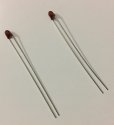Here is a photo of my pump with a nice black rubber skirt.
Opened the thermistor can and one contact is broken ... dunno if I broke it when was removing it or it was already broken.
Never seen a sensor which such a bad look, the head seems cooked... Can't weld it, the tin doesn't stick, the thermistor material is weird, and the readings are crazy, in the center reads 1300 ohms but if I move a bit gives all kind of readings.
The can diameter is 10mm, your thermister has a head of 6,5mm. It doesn't left much room for the gasoline to run freely.
Someone borrowed me a thermistor of 10K ohms, gonna try in the bike to see if the reserve light comes alive.
skirt: yep, I got the same one.
thermistor: "...seems cooked"- yeah, it is totally burnt. I'm surprised you can measure the resistance at all. It probably went into thermal runaway (got a little hot-> resistance drops-> more current-> got hotter: repeat until it smokes). Maybe check the other inline resistor (110ohms, 68ohms, or 7xxohms depending on the bike) which is near the regulator usually inside the loom (wtf!). It is just soldered onto a wire without support and easily breaks.
I cooked my thermistor by hooking it straight to 12v and watched the resistance slowly (and then exponentially fast) try to get to zero ohms. oops. well, I bought it to experiment, I guess.
btw, consider supporting the new thermistor with a drop of epoxy to the can sidewall (leaving the majority of the thermistor body clear).
can diameter/ thermistor clearance: absolutely no problem at all, less is better. All the gasoline comes in and out those 0.5mm holes in the can. The liquid gas (ugh) conducts the heat to the can and the can conducts the heat into the outside gas. The thermistor body is 5.4mm diameter, 3.2mm thick, and with the leads splayed to go to the top & bottom of the can: 5.9mm. I measured 9.4mm for the inside diameter of the can- no worries there. But I'd use epoxy for support and insulation, because the bare leads are not as thick as the stock thermistor. hell, put a heat shrink tube on the top lead too.
Before doing all these mods, maybe set up an experiment (without using the can or gas- maybe water?) with the thermistor hooked into your bike's circuit. Submerge and slowly raise the thermistor (live circuit) and make sure your LED works as it should. Don't hold it in your hands- it could go to 1000° in a second or two if something is wrong.
You might be able to emulate the circuit by using 2 different resistors at 2 different times. If you go this route, I'd probably try 1200ohms (tank full) and maybe 330ohms (tank empty? it's about 120°F or 50°C... which liquid gasoline could get I suppose. shit- maybe a smaller resistor). Also, I am not happy with my measurements of the thermistor I did last November- I used hot water but I also used an IR thermometer instead of my digital (conductive) thermometer. The low emissivity of stuff like water may have come into play.
Inspect the can mount strap for a hairline crack closest to the silver bar that mounts on the fuel pump holder.
hey, take pictures, take notes etc... you're going to be teaching me here soon.
good luck.






 . Installation will begin next week. Pictures will be provided.
. Installation will begin next week. Pictures will be provided.








